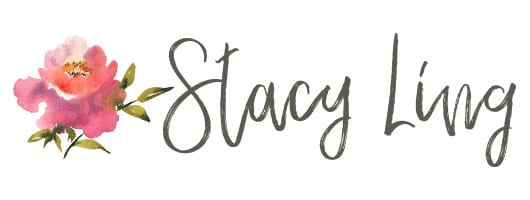Fall foliage plants offer a vibrant alternative to flowers. Explore this guide to create a stunning autumn garden with colorful leaves and textures.
I’m always chatting about flowers, but today, let’s dive into the captivating world of foliage. After all, foliage plays a crucial role in achieving year-round beauty in the garden. While some of these plants do bloom, their true magic lies in the breathtaking display of colors and textures they offer as autumn approaches.
Let’s explore ten exceptional plants that will keep your garden vibrant and alive with color long after the flowers have faded.
(Posts on stacyling.com may contain affiliate links. Click HERE for full disclosure.)

Why Foliage Matters as Much as Flowers
In the realm of gardens, foliage is like the unsung hero, adding depth, texture, and intrigue to the floral canvas. While flowers command attention with their vibrant colors, it’s the diverse palette of foliage that creates a captivating backdrop, amplifying their beauty.
Leaves, in shades from lush green to deep purple, and shapes from bold to delicate, weave a tapestry of patterns that enhance the garden’s aesthetic. The interplay of foliage and flowers creates a harmonious balance, allowing each element to shine while contributing to a visually engaging composition.
As seasons change, the evolving colors and textures of leaves provide an ever-changing narrative, ensuring the garden remains a living work of art, inviting exploration and admiration year-round.

Types of Fall Foliage Plants
Trees You’ll Love For Autumn
Maple (Acer spp.)
Maples are synonymous with fall, painting the landscape with a symphony of reds, oranges, and yellows. Varieties like Sugar Maple, Japanese Maple, and Red Maple are particularly renowned for their stunning fall displays. Their vibrant hues light up gardens and streetscapes, creating a warm and inviting atmosphere. If you have the space, consider planting one (or more!) this fall – you won’t regret it.
- USDA Hardiness Zones: Varies widely depending on species (e.g., Sugar Maple: 3-8, Japanese Maple: 5-8)
- Light Conditions: Full sun to partial shade
- Soil Conditions: Moist, well-drained, slightly acidic soil
- Bloom Time: Spring (inconspicuous flowers)
- Berries: Samara (winged seeds)
We’ve got a few different varieties here in the backyard zen garden that look stunning in fall. The branches weep and the plant blooms incredibly from the moment it leafs out in spring.


Dogwood (Cornus spp.)
While many dogwood species are known for their spring blooms, varieties like the Red Twig Dogwood steal the show in autumn. As the leaves turn a deep red, the bright red stems create a dramatic contrast, adding a unique visual element to the fall garden. Other dogwood varieties also offer beautiful fall foliage, making them versatile additions to any landscape.
- USDA Hardiness Zones: Varies depending on species (e.g., Red Twig Dogwood: 3-7, Flowering Dogwood: 5-9)
- Light Conditions: Full sun to partial shade
- Soil Conditions: Moist, well-drained, slightly acidic soil
- Bloom Time: Spring (showy bracts in Flowering Dogwood)
- Berries: Small, red berries (attractive to birds)
I don’t have a red twig dogwood here, but we do have a few other varieties that I absolutely love!


Shrubs: The Best Fall Foliage Plants
Callicarpa
Beautyberry, as the name suggests, is a sight to behold in the fall. Its vibrant purple berries cluster along the branches, creating a striking contrast against the green or turning foliage. These berries can persist well into the season, offering a long-lasting visual spectacle. The foliage itself also undergoes a transformation, further enhancing the shrub’s fall appeal.
- USDA Hardiness Zones: 5-8
- Light Conditions: Full sun to partial shade
- Soil Conditions: Moist, well-drained soil
- Bloom Time: Summer (small, pink or lavender flowers)
- Berries: Clusters of vibrant purple berries in fall
To be completely honest, the flowers are pretty insignificant but you should grow it for its fall beauty with foliage and purple berries. I grew beautyberry for many years in my former garden. Sadly, I don’t have one here…yet! It’s on my list to add though this fall.

Oakleaf Hydrangea
Oakleaf Hydrangea is a beloved shrub known for its large, oak-shaped leaves that turn rich shades of burgundy, red, and purple in autumn. This deciduous beauty adds depth and warmth to the fall landscape. Some cultivars even produce cone-shaped flower clusters that age to pink or maroon, extending the plant’s visual interest.
- USDA Hardiness Zones: 5-9
- Light Conditions: Full sun to partial shade (afternoon shade in hot climates)
- Soil Conditions: Moist, well-drained, acidic soil
- Bloom Time: Summer (large, cone-shaped white flower clusters that age to pink or maroon)
I grew one for well over 10 years in my former garden and it was one of the easiest fuss-free plants to grow. The foliage was gorgeous every single fall and I loved to incorporate it on my Thanksgiving table.
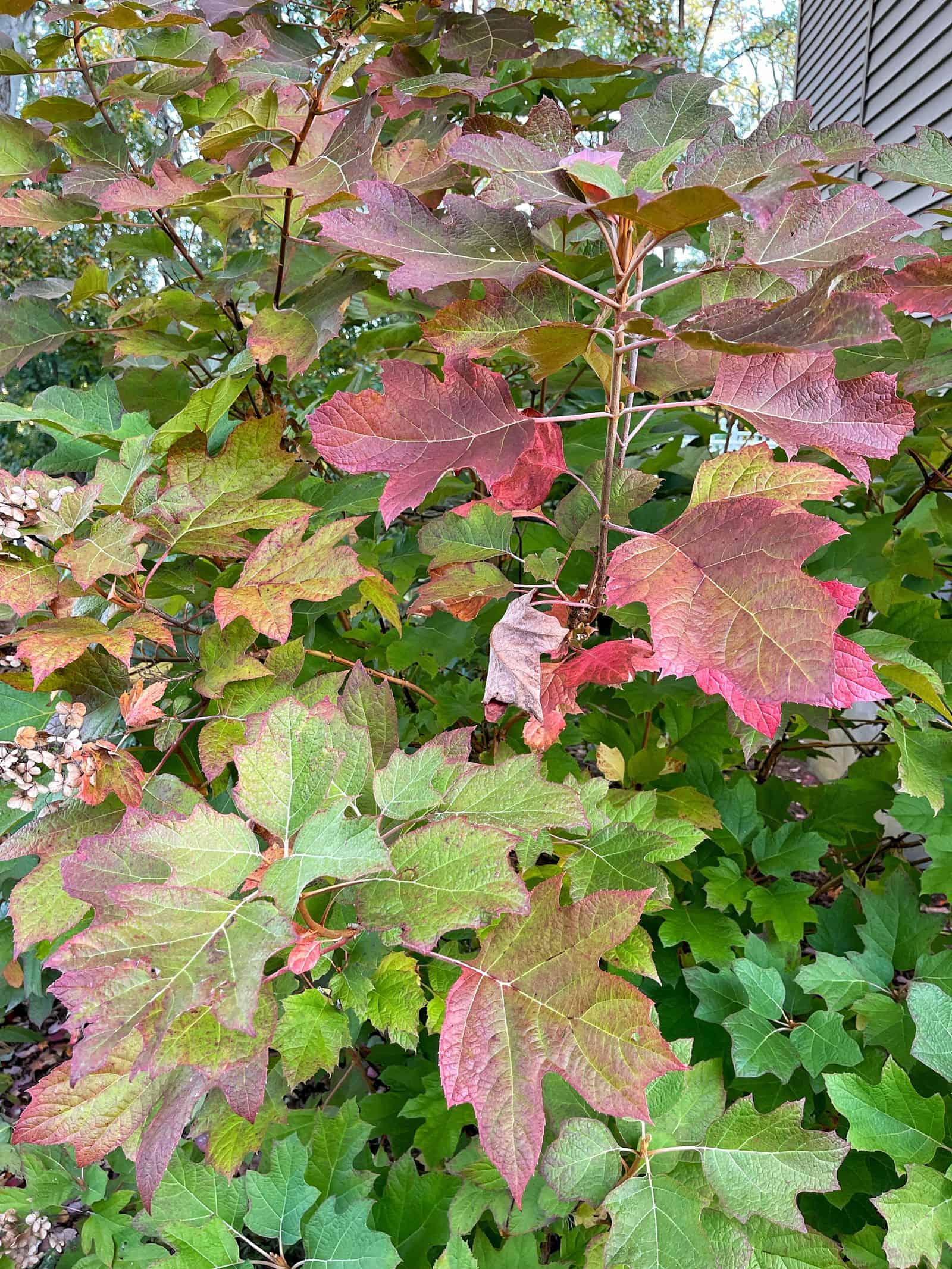
Viburnum (Viburnum spp.)
Viburnums are versatile shrubs that offer a range of fall attributes. Varieties like Arrowwood Viburnum and American Cranberrybush showcase foliage that transforms into deep maroon, red, and purple hues. Some viburnums also produce berries that change color, adding another layer of interest to the autumn garden.
- USDA Hardiness Zones: Varies depending on species (e.g., Arrowwood Viburnum: 2-8, American Cranberrybush: 2-7)
- Light Conditions: Full sun to partial shade
- Soil Conditions: Adaptable to various soil types, but prefers moist, well-drained soil
- Bloom Time: Spring (white or pink flowers)
- Berries: Colorful berries in fall (red, blue-black, etc., depending on species)
I’ve grown several different varieties through the years. They are easy to grow, look incredible throughout the seasons and the birds love them! It is a must-have flowering shrub for a low-maintenance garden.
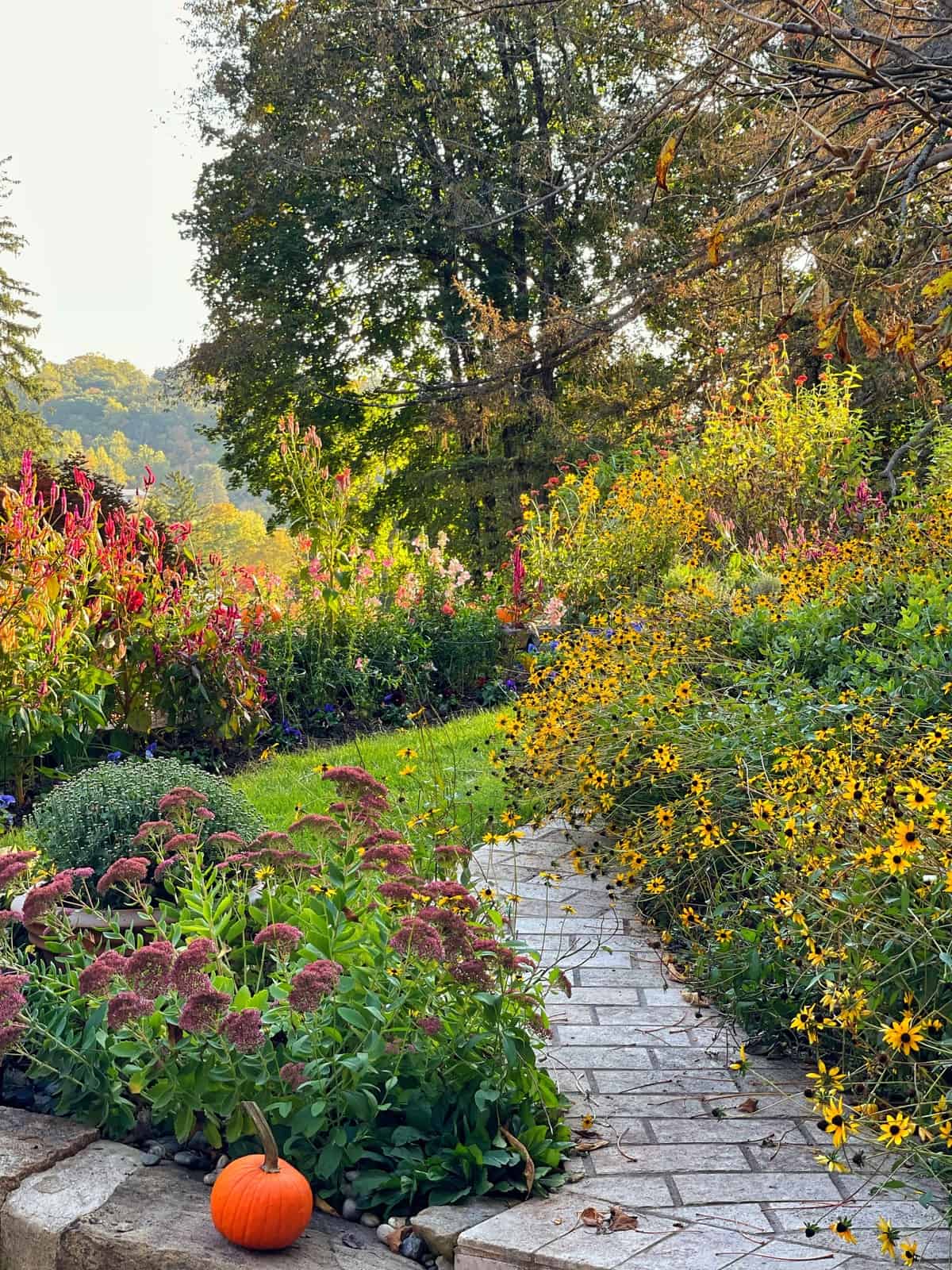
Spireas
Spireas are versatile shrubs that shine throughout the growing season, culminating in a vibrant display of fall foliage. Their leaves turn shades of fiery red, orange, and even purple, creating a dramatic spectacle in the autumn landscape.
- USDA Hardiness Zones: Varies depending on species (generally 3-8)
- Light Conditions: Full sun
- Soil Conditions: Well-drained soil
- Bloom Time: Spring or summer (abundant clusters of white, pink, or red flowers)
Whether as standalone specimens or as part of mixed plantings, these shrubs prove that they’re not just a fleeting sight but an integral component of a vibrant and lively garden year-round.
I’ve got a few spireas here on the property, but baby’s breath spirea gets me everytime with those spring blooms and gorgeous fall foliage!


Perennials With Fall Foliage Appeal
Coral Bells (Heuchera spp.)
Coral Bells are prized for their unique foliage, which takes on deeper and richer shades in the fall. Colors range from rich burgundy to earthy copper, adding depth and dimension to the garden. Many varieties offer beautiful foliage color throughout the growing season, making them versatile additions to any landscape
- USDA Hardiness Zones: 4-9
- Light Conditions: Partial shade to full shade (some cultivars tolerate more sun)
- Soil Conditions: Moist, well-drained soil
- Bloom Time: Spring to summer (delicate flower stalks with tiny, bell-shaped flowers)
I’ve got a few Peachberry Ice and Apple Twist varieties here that I absolutely adore from Proven Winners and Walters Gardens.
As an added bonus, I opt to decorate in late summer, early fall with huecheras instead of chrysanthemums so I can get that autumn color palette earlier without having to spend money on garden mums too early.


Sedum (Sedum spp.)
Sedums are not only drought-tolerant but also known for their captivating fall foliage. As temperatures cool, their succulent leaves transition from greens to shades of russet, burgundy, and even deep purple, lending warmth and coziness to the autumn landscape.
- USDA Hardiness Zones: Varies depending on species (generally 3-9)
- Light Conditions: Full sun
- Soil Conditions: Well-drained soil (tolerates drought)
- Bloom Time: Late summer to fall (clusters of pink, red, or purple flowers)
While I am a HUGE fan of sedum autumn joy, there are lots of other sedums to enjoy as well that are equally as fun and easy to grow.
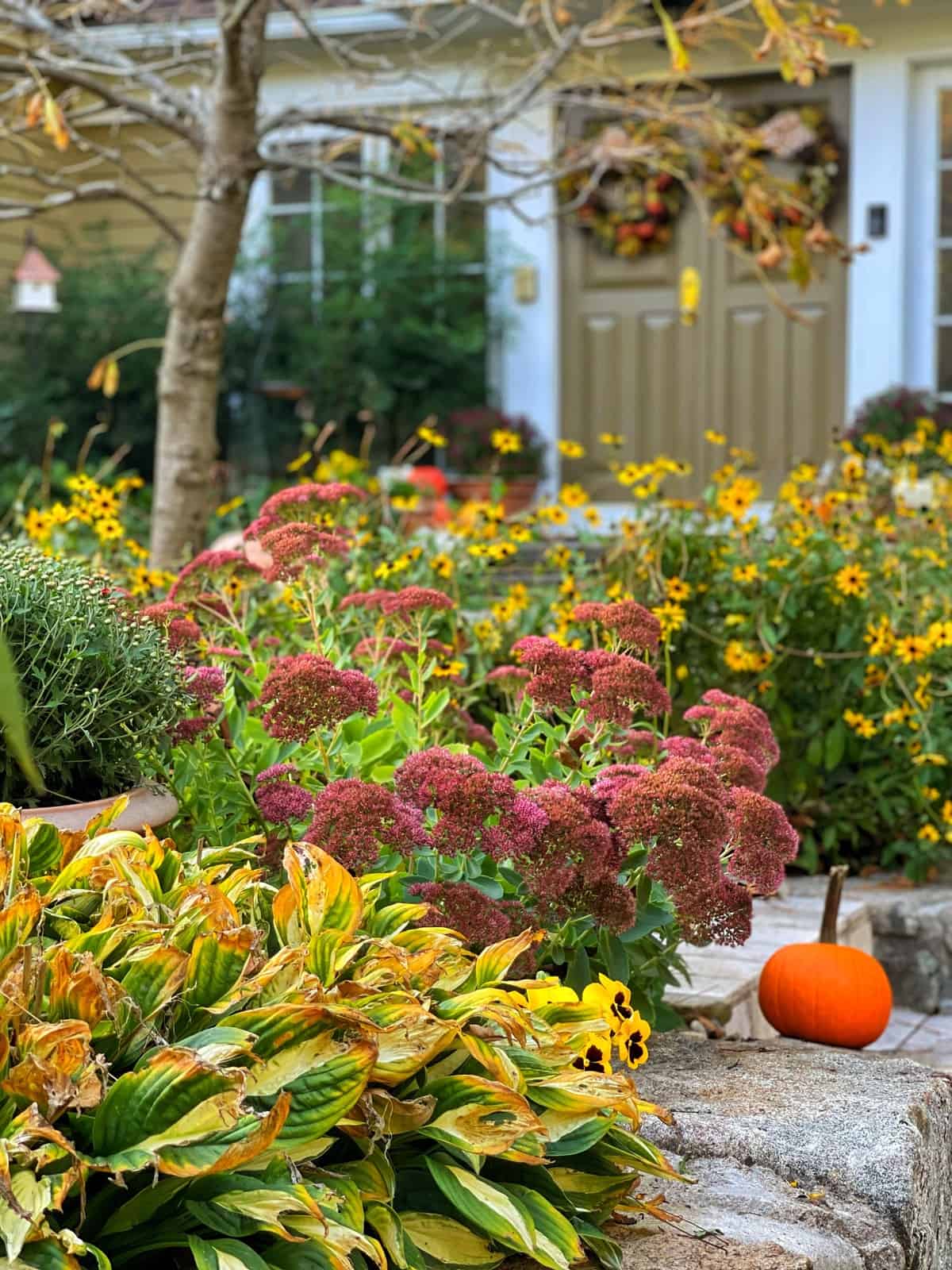
Japanese Forest Grass (Hakonechloa macra)
The elegant Japanese Forest Grass undergoes a stunning transformation in the fall. Its green blades turn to shades of golden yellow or fiery orange, creating a visual feast for the eyes. The grass’s graceful movement and changing hues add an ethereal quality to the autumn garden.
- USDA Hardiness Zones: 5-9
- Light Conditions: Partial shade to full shade
- Soil Conditions: Moist, well-drained soil
- Bloom Time: Summer (inconspicuous flowers)
I wasn’t able to grow this in my former garden because I didn’t have enough shade space for them. But I grow it here. And let me be the first to tell you how GORGEOUS it is to grow.
From the chartreuse blades of grass that add texture and movement to shadier spots to their changing fall foliage color, it can’t be rivaled. It’s a must-have if you have some shady spots you’d like to brighten up!

Barrenwort (Epimedium)
Barrenwort, or Epimedium, is a charming perennial that offers a subtle yet elegant fall display. Its delicate, heart-shaped leaves transform into shades of bronze, copper, and burgundy, adding a touch of sophistication to the garden.
- USDA Hardiness Zones: 5-8
- Light Conditions: Partial shade to full shade
- Soil Conditions: Moist, well-drained, humus-rich soil
- Bloom Time: Spring (delicate, orchid-like flowers in various colors)

Barrenwort’s fall foliage isn’t a bold blaze of color, but rather a quiet and refined display that adds depth to the garden’s overall composition.
For those who appreciate a more understated approach to fall landscaping, barrenwort proves that sometimes, it’s the gentle transitions that leave the most lasting impressions.
Until moving here, I hadn’t grown it before. But now that I do? It’s an easy plant to grow that creates a manageable groundcover and looks beautiful throughout the growing season with a gorgeous finale in fall.


Tips for Choosing Fall Foliage Plants
- Consider Your Climate and Soil Conditions: Select plants that are well-suited to your local environment to ensure their success and longevity.
- Think About Size and Placement: Choose plants that fit the available space and complement the overall design of your garden.
- Aim for a Variety of Colors and Textures: Create visual interest by combining plants with different foliage characteristics.
Caring for Fall Foliage Plants
- Planting and Watering: Follow proper planting and watering techniques to establish healthy plants.
- Fertilizing and Pruning: Provide appropriate fertilization and pruning to maintain plant health and encourage vibrant fall color.
Inspirational Ideas
Imagine a tapestry of fiery maples juxtaposed with the deep purple hues of oakleaf hydrangeas. Picture the delicate dance of Japanese Forest Grass as its golden blades sway in the autumn breeze, complemented by the subtle elegance of barrenwort. The possibilities are endless! Let these combinations inspire you to create your own breathtaking fall foliage display.
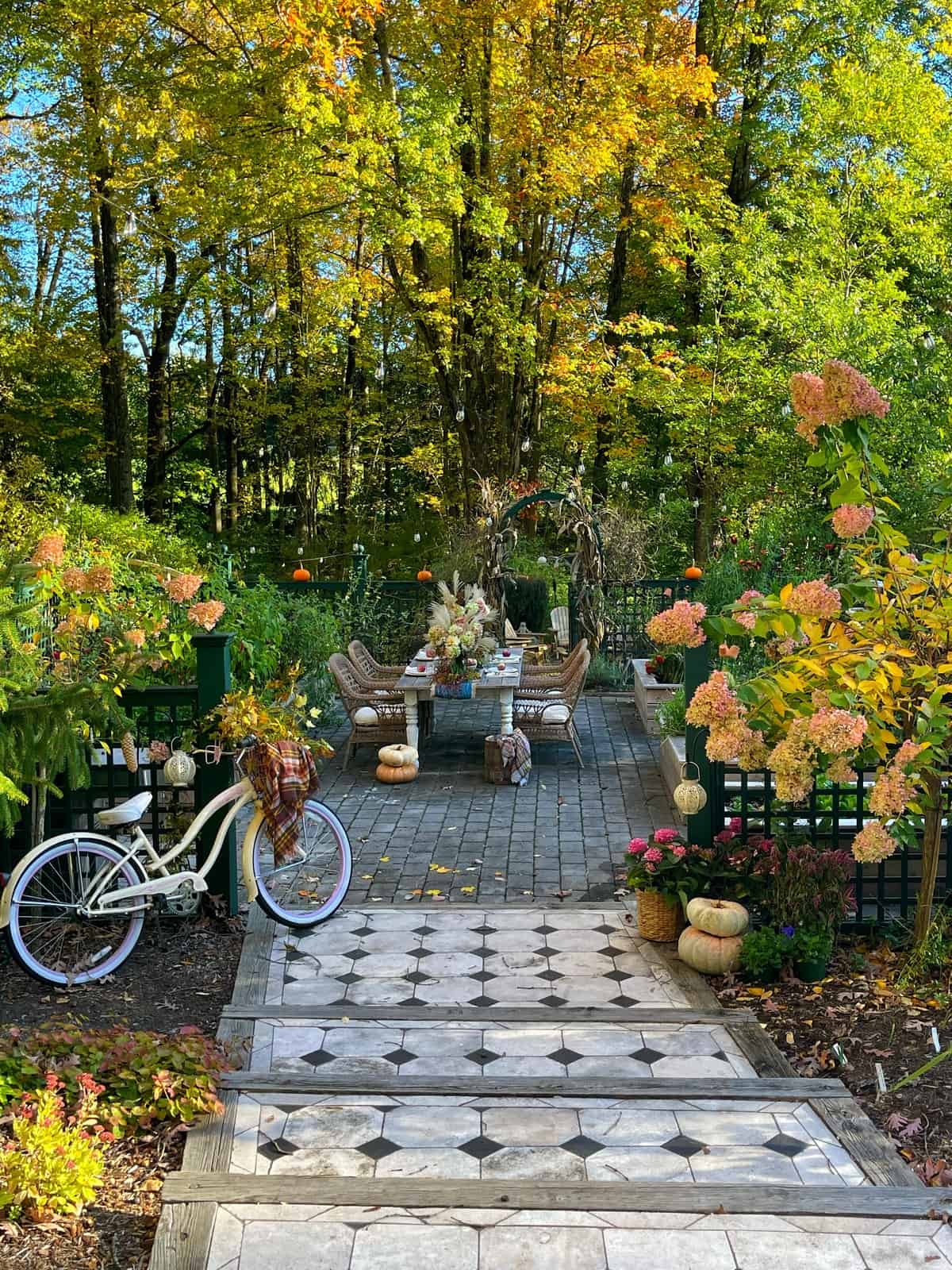
Final Thoughts About Fall Foliage Plants
Fall foliage plants offer a captivating alternative to flowers, extending the beauty of your garden well into the autumn season. By incorporating a variety of trees, shrubs, and perennials with stunning fall colors and textures, you can create a landscape that delights the senses and celebrates the changing seasons.
Embrace the beauty of autumn and experiment with different plant combinations. Let your garden become a canvas for nature’s artistry, showcasing the vibrant hues and textures that make fall so special.
Remember: Don’t hesitate to share your fall foliage garden creations with me! I’d love to see how you’ve incorporated these plants into your landscape.
- Which of these fall foliage plants are you most excited to try in your garden?
- Share photos of your autumn garden transformations with us on social media!
I would love to know more in the comments below. For more fall foliage planting ideas, read this article from the Penn State Cooperative Extension.
To drill down on more beginner gardening techniques and tips, please read these posts:
- Flower Gardening 101
- Growing a Cut Flower Garden for Beginners
- Container Garden Ideas for Beginners
- How to Start a Vegetable Garden
- Herb Gardening for Beginners
Thank you so much for following along.
Enjoy a beautiful day! xo
